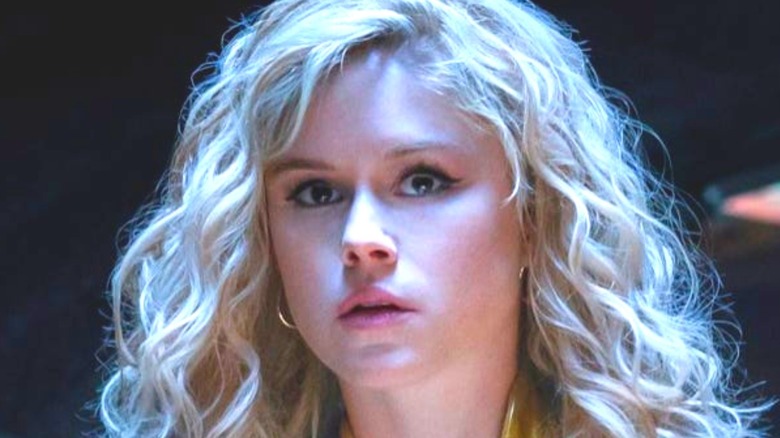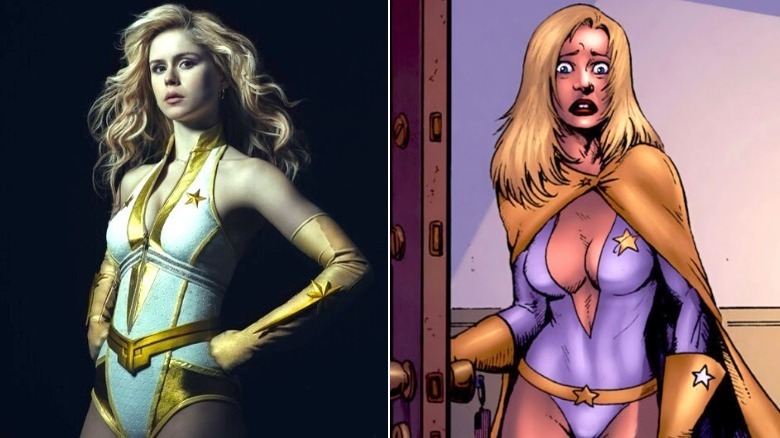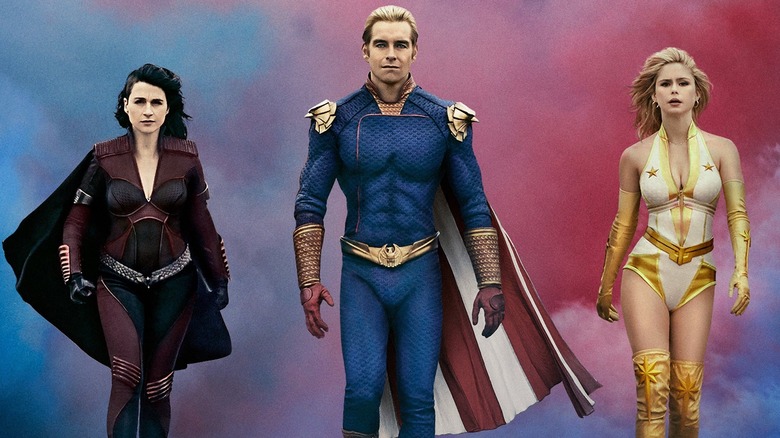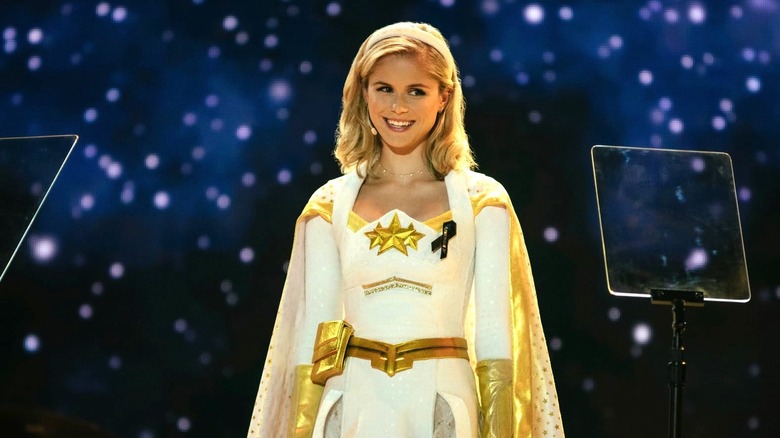Why Starlight's Costume In The Boys Makes No Sense
Amazon's hit R-rated superhero series "The Boys," based on the comics of the same name by Garth Ennis and Darick Robertson, has garnered a huge fanbase over the course of the first two seasons, and with good reason. Starring Jack Quaid as Hughie, a young man who joins forces with Karl Urban's Billy Butcher after a member of the Seven — the country's main superhero team — kills his girlfriend, "The Boys" is a high-octane show that challenges expectations. The series presents a dark take on a world inhabited by superheroes, in which powered individuals take advantage of their privilege for influence and greed.
On the superhero side of things, Antony Starr plays Homelander, the leader of the Seven, along with Dominique McElligott as Queen Maeve, Jessie T. Usher as A-Train, Chace Crawford as The Deep, and others. Erin Moriarty stars as Annie January, a.k.a. Starlight, the newbie to the Seven who has her whole worldview rocked when she finds out the heroes she looked up to aren't much better than the criminals they lock up. As a part of her introduction to the group as its newest member, Starlight gets an upgraded costume change, though the "upgrade" part is a matter of opinion. She changes from a girly white look with a cheerleader skirt and cape, to a limited leotard that shows a lot more skin, a choice Starlight is against but goes along with to be accepted by Vought International and the team.
While Starlight's costume definitely appeals to Vought's intended audience, giving her a much more mature look, it's safe to say that the outfit makes no sense for a superhero whose job is fighting criminals and using her abilities, and it certainly does little to protect her from harm.
The Boys TV series does what it can to make her tiny outfit functional
In comparison to the comic book version of the outfit, the television adaptation's Starlight costume is relatively accurate, while still being reasonably functional. For starters, the show gets rid of the cape, while also giving her bodysuit a little more coverage and support, though not much. Obviously, this is the point of the design, to show that Vought values her sexual appeal over tactical usefulness. But Starlight does a lot more fighting in the show — if she does any fighting at all in the comics — so the outfit needs to be believably practical, which is shown through the thick, stretchy material and the more structured bodice, but it's still debatable whether it's functional or not.
But even with these slight adjustments, it still seems almost impossible for someone to fight criminals in an outfit this bare, and there's barely any protection against attacks to her arms and legs. Starlight also wears high-heeled boots, which many have pointed out as simply unfeasible for a superhero to comfortably work in, much less someone like Wonder Woman who does plenty of jumping and acrobatics. With "The Boys," these design choices are done to highlight the constant objectification of women in comics and superhero shows, in which they are commonly outfitted in uncomfortable, overexposed, and inefficient clothes.
The comics try to make a point about oversexualization but only add to the issue
Instead of using Starlight's costume to highlight the oversexualization of female characters in comics and superhero movies, to the point where the outfit doesn't make any logical sense, "The Boys" comics just take part in the issue and continue the sexualization. In the original comics, Starlight experiences the same sexism and unwelcome control from Vought as she does in the show, but it's much more overt, and almost too intense to be excused as anything but indulgent. In fact, there's very little story for Starlight outside of the Seven treating her badly and abusing her, particularly obvious in the show's choice to tame the sexual abuse between Starlight and The Deep, which originally occurs with Homelander and other members of the Seven and is much more graphic (via Screen Rant).
The comics use the same inaccurate, biologically impossible drawing style that created the sexist issue in the first place. While there's a way to make a point about female superheroes' costumes while also improving upon past mistakes,"The Boys" comics don't do that. Add to this the fact that Starlight is shown naked half the time she appears, the character of Kimiko, played by Karen Fukuhara in the show, is only known as "The Female," and whatever's up with Queen Maeve's storylines, and the TV adaptation is definitely a huge step up for Starlight and female representation.
The Boys TV show succeeds where the comics don't
While the new outfit fails as a superhero's uniform, "The Boys" TV show uses the costume to add to Starlight's personal journey as she figures out what sort of superhero she wants to be. Supporting this character development, Starlight finally returns to her original costume at the end of Season 2, the one that symbolizes the original, pure moral reasons she wanted to be a superhero and save lives in the first place. "The Boys" makes Starlight into a fully-formed character and succeeds in what the comics try — and fail — to do, by showing how demeaning the oversexualization is and Starlight overcoming it.
In an interview with Rotten Tomatoes, "The Boys" show creator Eric Kripke spoke about why they made Starlight a main character in the show, highlighting how minimal her story is in the source material. He explained, "We really wanted her to be one of the leads because, frankly, for the simple reason that just truly likable characters in this world are really thin on the ground." In Season 2, Starlight takes control of her situation, pretending to embrace the Seven and her new uniform in order to convince Vought of her loyalty and spy on them for Hughie and the Boys. Thankfully, Starlight is able to eventually return to her chosen costume, leaving behind the bare bodysuit that symbolizes everything she stands against.



